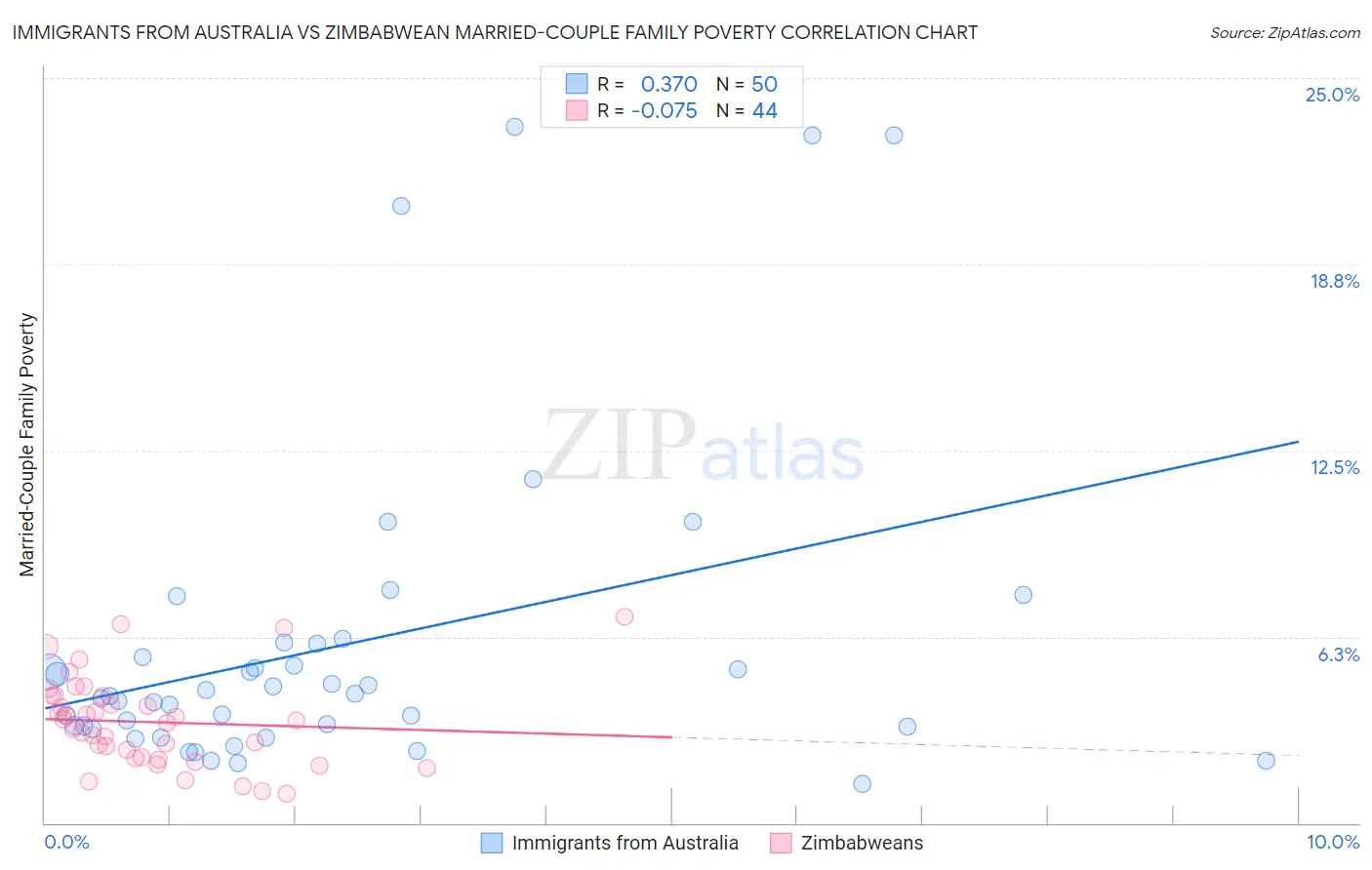Immigrants from Australia vs Zimbabwean Married-Couple Family Poverty
COMPARE
Immigrants from Australia
Zimbabwean
Married-Couple Family Poverty
Married-Couple Family Poverty Comparison
Immigrants from Australia
Zimbabweans
4.4%
MARRIED-COUPLE FAMILY POVERTY
99.6/ 100
METRIC RATING
62nd/ 347
METRIC RANK
4.1%
MARRIED-COUPLE FAMILY POVERTY
99.9/ 100
METRIC RATING
21st/ 347
METRIC RANK
Immigrants from Australia vs Zimbabwean Married-Couple Family Poverty Correlation Chart
The statistical analysis conducted on geographies consisting of 225,813,318 people shows a mild positive correlation between the proportion of Immigrants from Australia and poverty level among married-couple families in the United States with a correlation coefficient (R) of 0.370 and weighted average of 4.4%. Similarly, the statistical analysis conducted on geographies consisting of 69,119,087 people shows a slight negative correlation between the proportion of Zimbabweans and poverty level among married-couple families in the United States with a correlation coefficient (R) of -0.075 and weighted average of 4.1%, a difference of 7.4%.

Married-Couple Family Poverty Correlation Summary
| Measurement | Immigrants from Australia | Zimbabwean |
| Minimum | 1.3% | 1.0% |
| Maximum | 23.4% | 6.9% |
| Range | 22.1% | 5.9% |
| Mean | 6.0% | 3.4% |
| Median | 4.3% | 3.4% |
| Interquartile 25% (IQ1) | 3.2% | 2.2% |
| Interquartile 75% (IQ3) | 6.0% | 4.3% |
| Interquartile Range (IQR) | 2.8% | 2.1% |
| Standard Deviation (Sample) | 5.4% | 1.5% |
| Standard Deviation (Population) | 5.3% | 1.5% |
Similar Demographics by Married-Couple Family Poverty
Demographics Similar to Immigrants from Australia by Married-Couple Family Poverty
In terms of married-couple family poverty, the demographic groups most similar to Immigrants from Australia are Okinawan (4.4%, a difference of 0.010%), Tlingit-Haida (4.4%, a difference of 0.12%), Immigrants from Sweden (4.4%, a difference of 0.19%), Immigrants from Sri Lanka (4.4%, a difference of 0.36%), and Czechoslovakian (4.4%, a difference of 0.74%).
| Demographics | Rating | Rank | Married-Couple Family Poverty |
| French | 99.7 /100 | #55 | Exceptional 4.3% |
| Immigrants | Zimbabwe | 99.7 /100 | #56 | Exceptional 4.3% |
| Immigrants | Netherlands | 99.7 /100 | #57 | Exceptional 4.3% |
| Czechoslovakians | 99.7 /100 | #58 | Exceptional 4.4% |
| Immigrants | Sweden | 99.6 /100 | #59 | Exceptional 4.4% |
| Tlingit-Haida | 99.6 /100 | #60 | Exceptional 4.4% |
| Okinawans | 99.6 /100 | #61 | Exceptional 4.4% |
| Immigrants | Australia | 99.6 /100 | #62 | Exceptional 4.4% |
| Immigrants | Sri Lanka | 99.6 /100 | #63 | Exceptional 4.4% |
| Immigrants | Bulgaria | 99.5 /100 | #64 | Exceptional 4.4% |
| Macedonians | 99.4 /100 | #65 | Exceptional 4.4% |
| Immigrants | Serbia | 99.4 /100 | #66 | Exceptional 4.4% |
| Immigrants | Canada | 99.4 /100 | #67 | Exceptional 4.4% |
| Slavs | 99.4 /100 | #68 | Exceptional 4.4% |
| New Zealanders | 99.4 /100 | #69 | Exceptional 4.4% |
Demographics Similar to Zimbabweans by Married-Couple Family Poverty
In terms of married-couple family poverty, the demographic groups most similar to Zimbabweans are Maltese (4.1%, a difference of 0.030%), Immigrants from Ireland (4.1%, a difference of 0.27%), Immigrants from Singapore (4.1%, a difference of 0.37%), Bhutanese (4.1%, a difference of 0.39%), and Eastern European (4.1%, a difference of 0.62%).
| Demographics | Rating | Rank | Married-Couple Family Poverty |
| Slovaks | 100.0 /100 | #14 | Exceptional 4.0% |
| Poles | 100.0 /100 | #15 | Exceptional 4.0% |
| Germans | 100.0 /100 | #16 | Exceptional 4.0% |
| Filipinos | 100.0 /100 | #17 | Exceptional 4.0% |
| Italians | 100.0 /100 | #18 | Exceptional 4.0% |
| Immigrants | Ireland | 99.9 /100 | #19 | Exceptional 4.1% |
| Maltese | 99.9 /100 | #20 | Exceptional 4.1% |
| Zimbabweans | 99.9 /100 | #21 | Exceptional 4.1% |
| Immigrants | Singapore | 99.9 /100 | #22 | Exceptional 4.1% |
| Bhutanese | 99.9 /100 | #23 | Exceptional 4.1% |
| Eastern Europeans | 99.9 /100 | #24 | Exceptional 4.1% |
| Immigrants | Taiwan | 99.9 /100 | #25 | Exceptional 4.1% |
| Cypriots | 99.9 /100 | #26 | Exceptional 4.1% |
| Danes | 99.9 /100 | #27 | Exceptional 4.1% |
| Scandinavians | 99.9 /100 | #28 | Exceptional 4.1% |